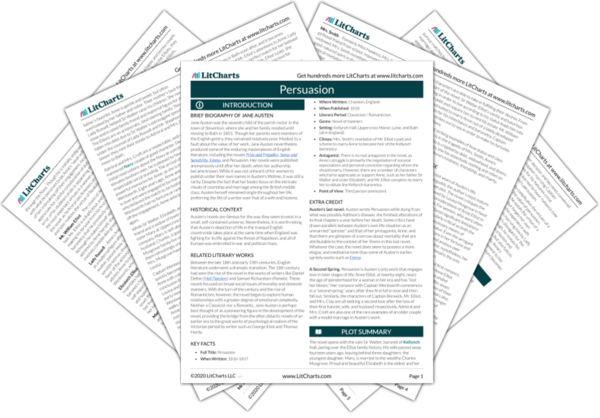Welcome to the LitCharts study guide on Jane Austen's Persuasion. Created by the original team behind SparkNotes, LitCharts are the world's best literature guides.
Persuasion: Introduction
Persuasion: Plot Summary
Persuasion: Detailed Summary & Analysis
Persuasion: Themes
Persuasion: Quotes
Persuasion: Characters
Persuasion: Symbols
Persuasion: Literary Devices
Persuasion: Quizzes
Persuasion: Theme Wheel
Brief Biography of Jane Austen

Historical Context of Persuasion
Other Books Related to Persuasion
Key Facts about Persuasion
- Full Title: Persuasion
- When Written: 1816-1817
- Where Written: Chawton, England
- When Published: 1818
- Literary Period: Classicism / Romanticism
- Genre: Novel of manners
- Setting: Kellynch Hall, Uppercross Manor, Lyme, and Bath (all in England).
- Climax: Mrs. Smith’s revelation of Mr. Elliot’s past and scheme to marry Anne to become heir of the Kellynch baronetcy.
- Antagonist: There is no real antagonist in the novel, as Anne’s struggle is primarily the negotiation of societal expectations and personal conviction regarding whom she should marry. However, there are a number of characters who fail to appreciate or support Anne, such as her father Sir Walter and sister Elizabeth, and Mr. Elliot conspires to marry her to obtain the Kellynch baronetcy.
- Point of View: Third person omniscient
Extra Credit for Persuasion
Austen’s last novel. Austen wrote Persuasion while dying from what was possibly Addison’s disease; she finished alterations of its final chapters a year before her death. Some critics have drawn parallels between Austen’s own life situation as an unmarried “spinster” and that of her protagonist, Anne, and that there are glimpses of a sorrow about mortality that are attributable to the context of her illness in this last novel. Whatever the case, the novel does seem to possess a more elegiac and meditative tone than some of Austen’s earlier, spritely works such as Emma
A Second Spring. Persuasion is Austen’s only work that engages love in later stages of life; Anne Elliot, at twenty-eight, nears the age of spinsterhood for a woman in her era and has “lost her bloom.” Her romance with Captain Wentworth commences in a “second spring,” years after they first fall in love and then fall out. Similarly, the characters of Captain Benwick, Mr. Elliot, and Mrs. Clay are all seeking a second love after the loss of their first fiancée, wife, and husband respectively. Admiral and Mrs. Croft are also one of the rare examples of an older couple with a model marriage in Austen’s work.







